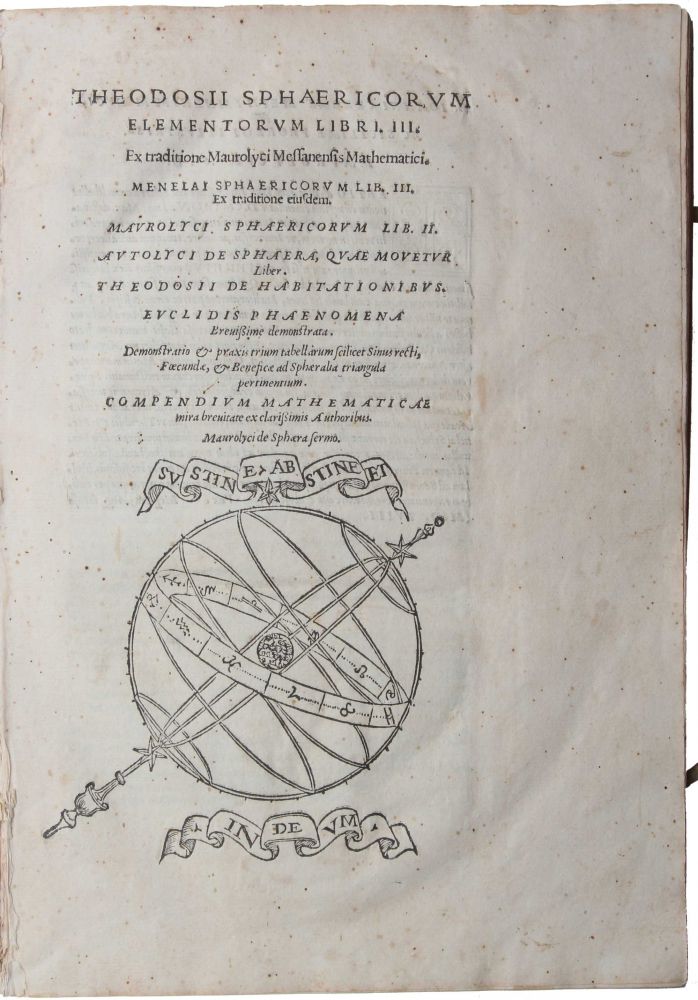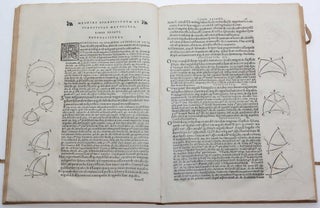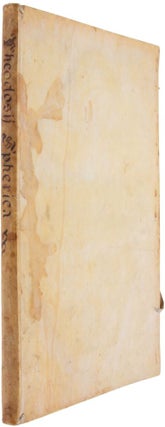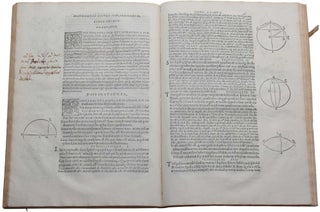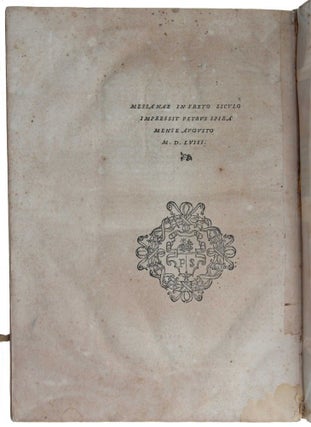Theodosii sphaericorum elementorum libri III ex traditione Maurolyci, Messanensis Mathematici. Menelai sphaericorum lib III. Ex traditione ejusdem. Maurolyci sphaericorum lib II. Autolyci de sphaera, quae movetur Liber. Theodosii de habitationibus. Euclidis phaenomena. Brevissime demonstrata. Demonstratio et praxis, trium tabellarum scilicet Sinus recti, Foecundae et Beneficae ad Sphaeralia triangula pertinentium. Compendium mathematicae mira brevitate ex clarissimis Authoribus. Maurolyci de Sphaera sermo.
Messina: Pietro Spira, August 1558. First edition, ‘excessively rare’ (Sotheran), of this collection of works on ‘spherics’, the geometrical and trigonometrical techniques necessary for the description of the motion of the celestial bodies, including Maurolico’s Latin translations of works by four ancient Greek writers, Autolycus, Menelaus, Euclid and Theodosius, those of the first two authors constituting the first printed editions. Maurolico, one of the most original mathematicians of the 16th century, appended his own original propositions on sphaerics, probably based on astronomical observations made from 1548 to 1550 in Sicily, contained in his Sphaericorum libri II, Sermo de Sphaera, and Compendium mathematicae. He also includes a number of trigonometrical tables, including the first printed tables of secants, the Tabula Benefica, “in frank imitation of Regiomontanus’s Tabula Feconda for tangents. It therefore seems that Maurolico had, independently of Rheticus, discovered the use of secants” (Rose, p. 173). Spherics, the geometry of the sphere, was regarded by the ancient Greeks as a branch of astronomy rather than of geometry. “The year 1558 was a turning point in the spherics tradition because in that year the printed versions of the text ended their dependence on the medieval heritage and participated in the Renaissance of mathematics … In Messina, in the same year, 1558, Francesco Maurolico … published the Sphaericorum elementorum libri tres ex traditione Maurolyci. Persuaded of the dignity of mathematical knowledge, Maurolico regretted the silence that had fallen on the ancient works of Euclid, Archimedes, Theodosius, Menelaus, Apollonius, and Serenus, as well as the corruption of their texts. Hence, he carried out a program of restoring the ancient works so that the knowledge they contained—set free of errors, gaps and imperfections—should shine again. Far from pursuing a philological and faithful reconstruction made by strictly adhering to the manuscript sources, Maurolico was guided by an interest in the enrichment of scientific knowledge. Hence, he integrated the original works with various contributions made throughout the centuries and presented the works’ content following a rigour that he regarded as proper to mathematics” (Malpangotti, pp. 78-79). OCLC lists copies in the US at Burndy (although the work is not listed in the Huntington Library catalogue), Columbia, Michigan State and Oklahoma. No copies listed on ABPC/RBH. The volume’s original dedication of 1555 was to no less a personage than Charles V, whom Maurolico had met in Sicily in 1535. After the emperor’s death, however, Maurolico rededicated the printed book of 1558 to the viceroy La Cerda with a request that the book be transmitted to Philip II. No doubt Maurolico expected several advantages from this high patronage. In the first place, there would be continued sponsorship of his printing programme, and indeed Maurolico prefaces the collection with a new draft of his Index lucubrationum of 1540 [see below] … There seems to have been a hope on Maurolico’s part that the patronage of the court might commend his book to the schools whose use of Sacrobosco he keenly criticised. Thus, the dedication in noting that spherics is essential to both astronomers and geometers, laments that this science lies neglected in the schools, a defect of the schools no longer to be tolerated. For this reason, he has tried to restore the spherics of Theodosius and Menelaus working from the most corrupt of texts. (This explains why Maurolico often gives only a note in place of the proofs.)” (Rose, p. 173). The order in which the works are presented by Maurolico is pedagogical rather than historical. He begins with his own De sphaera sermo, which is a non-technical introduction to astronomy on the sphere (‘inter Sicut planas circulum, ita inter solidas figuras Sphaeram maximae excellentiae them multis plane rationibus constat'’). This is followed by his translation of the Sphaerica of Theodosius of Bithynia (ca. 160 BC - ca. 100 BC), a mathematician and astronomer who lived in Tripoli on the Fenicia coast who is thought to be a younger contemporary of Hipparchus, the inventor of trigonometry (although no work by Hipparchus on this subject has survived). Arranged in three books, the Sphaerica discusses the properties of circular arcs lying on the surface of a sphere, notably great circles. Maurolico’s version is based on a Latin manuscript of Plato of Tivoli (in turn prepared on the basis of an Arabic translation). The Sphaerica first appeared in the compendium Sphaera published at Venice in 1518; the first separate Latin edition at Vienna in 1529; and the editio princeps of the Greek text at Paris in the same year as the present work. Maurolico “retained all the propositions [from Plato of Tivoli’s version], adopting the enunciations verbatim. Nevertheless, he introduced substantial changes to the work, adding further propositions, whose number increased from 79 to 84, reworking the demonstrations according to the requirements of modernity and renewal, which also involved the iconographic apparatus” (Malpangotto, p. 93). Maurolico’s commentary contained short tables of sines, tangents and secants, probably inspired by Rheticus’ tables in his Canon doctrinæ triangulorum (1551), but in part recomputed directly using Regiomontanus’ original tables of sines. Maurolico next presents his translation of the Sphaericorum of Menelaus of Alexandria (fl. 100 AD). “Menelaus’ major contribution to the rising science of trigonometry was contained in his Sphaerica, in three books. It is this work which entitles him to be regarded as the founder of spherical trigonometry and the first to have disengaged trigonometry from spherics and astronomy and made it a separate science” (DSB). The book introduces the concept of spherical triangle (a figure formed by three great circle arcs, which he named "trilaterals") and proves Menelaus’s theorem on the ratios of the lengths of the segments in which the sides of a triangle are divided by a straight line that intersects them all (and its analogue for spherical triangles).The work has not survived in the original Greek, and Maurolico’s translation, the first printing of the text in any form, was at first thought to have been based on an Arabic manuscript, but is now believed to derive from a Latin translation by Gerard of Cremona (d. 1187). Maurolico’s translation of Menelaus is followed by his own work Sphaericorum, in two books. This is a continuation and completion of the Sphaericorum of Menelaus, and is “among the most interesting books on the subject published between the sixteenth and seventeenth centuries”, according to the National Edition of the works of Maurolico (currently in preparation). Maurolico informs us that his sources for this work, apart from Theodosius, Menelaus and Ptolemy's Almagest, are the treatises of Thabit ibn Qurra, Geber, Peurbach and Regiomontanus. “The separate preface to Maurolico’s own Sphaericorum Libri II is interesting for its short historical account of spherics. Starting from Theodosius, he traces the science through the Greeks (Menelaus and Ptolemy), and Arabs (Thabit and Geber) to the moderns (Peurbach and Regiomontanus). But even though Regiomontanus’s De triangulis is not to be ignored, Maurolico still believes that the subject still requires more doctrina” (Rose, pp. 173-174). The next work in the volume is Maurolico’s translation of De sphaera quae movetur by Autolycus of Pitane (fl. 300 BC), which is believed to be the oldest mathematical treatise from ancient Greece that is completely preserved (all earlier Greek mathematical works are reconstructed from later summaries, commentaries, or descriptions of the works). One reason for its survival is that it had originally been part of a widely used collection called the “Small Astronomy”, as opposed to the “Great Astronomy”, i.e., Ptolemy’s Almagest. Maurolico’s translation is the first complete printing of On the moving sphere – see Hultsch, p. xvi (extracts had appeared in Giorgio Valla’s De Expetendis et Fugiendis Rebus Opus, published in 1501). It is almost certain that Autolycus based On the moving sphere on the earlier works of Eudoxus, whose system of concentric rotating spheres he defends. The book includes 12 questions on spherical astronomy, and discusses the aspect of the heavens and the position of the different celestial circles, in connection with geographical latitude. “In On the moving sphere, a sphere is considered to move about an axis extending from pole to pole. Four classes of circular sections through the sphere are assumed: (1) great circles passing through the poles; (2) the equator and other, smaller, circles that are sections of the sphere formed by planes at right angles to the axis – these are the “parallel circles”; (3) great circles oblique to the axis of the sphere. The motion of points on the circles is then considered with respect to (4) the section formed by a fixed plane through the center of the sphere. A circle of class (3) is the ecliptic or zodiac circle, and (4) is equivalent to the horizon circle, which defines the visible and invisible parts of the sphere” (DSB). Maurolico translation of Autolycus is followed his translation of Theodosius’s De Habitationibus, the first printed edition, which treats the astronomical phenomena observed in places of habitation, and how these vary according to the latitude of the observer’s location. Partucliar attention is devoted to extreme latitudes, such as 90°, 0°, and the complement 66° of the obliquity of the ecliptic. Euclid makes use of Autolycus’ work in his Phaenomena, the last of the four major works on sphaerics to appear in the volume. Euclid’s only astronomical work, it was composed not much later than the work of Autolycus, to which it refers, and like it formed part of the “Little Astronomy”. “The preface gives reasons for believing that the universe is a sphere and includes some definitions and technical terms. Euclid in this work is the first writer to use the term “horizon” absolutely – Autolycus had written of the “horizon (i.e. bounding circle)” – and he introduces the term “meridian circle”. The propositions set out the geometry of the rotation of the celestial sphere and prove that stars situated in certain positions will rise or set at certain times... It is manifest that Euclid drew on Autolycus, but both of them cite without proof a number of propositions, which suggests that they had in their hands a still earlier textbook of sphaeric, which Tannery conjectured to have been the composition of Eudoxus. Many of the[se] propositions are proved in the Sphaerica of Theodosius, written several centuries later” (DSB). The Phaenomena survives in the original Greek, and was first published in Latin translation with Zamberti’s edition of the Elements (Venice, 1505). The translation of Autolycus is followed by three sets of tables, together with directions for their use, the Tabellarum sinus recti, foecundae et beneficae. These are, respectively, tables of sines, tangents and secants. The tables of sines and tangents are based on Regiomontanus’ Tabulae directionum (Nuremberg, 1475), but the table of secants is the first to be published, although Copernicus had preceded Maurolico in the use of such tables. The volume concludes with a table of declinations and right ascensions and Maurolico’s Compendium mathematicae, a collection of synopses of works by Euclid, Theodosius, Menelaus, Archimedes, Apollonius, and Maurolico himself. Maurolico’s translations of Autolycus, Euclid, Menelaus and Theodosius, as well as his own works on sphaerics, were included by Mersenne in his Synopsis mathematica (Paris, 1626), although Mersenne reproduced only the propositions, corollaries, lemmata and scholia, omitting the proofs. This material was reprinted again in Mersenne’s Universae geometriae (Paris, 1644). TheNeapolitan mathematicianG.D’Auria had earlier contributedto the dissemination of the work, adding Maurolico’s notestohis editionsof Autolycus and Theodosius (Rome, 1587) and Euclid’s Phaenomena (Rome, 1591). Maurolico’s family came from Greece, from which they had fled to Sicily to escape the Turks. Maurolico (1494-1575) learned Greek, as well as astronomy, from his father. In 1521 he was ordained priest, and in 1550 he was made abbot of Santa Maria del Parto by the Viceroy of Sicily, Juan de la Cerda, to whom the present work is dedicated (there is also a second dedication to Charles V). Maurolico held a number of civil commissions in Messina, and like his father became master of the Messina mint. Most importantly, he gave public lectures on mathematics at the University of Messina, where he was appointed professor in 1569. In the Index lucubrationum Maurolyci, contained in the present volume, Maurolico lists some thirty of his works then in manuscript which he expected to be published (about 85 works are now known to survive in printed or manuscript form). Although only a few of these were actually published, these are enough to show him to have been an outstanding scholar. In addition to producing editions of classical works, Maurolico published an important Cosmographia (Venice, 1543), and the Photismi de lumine (Naples, 1611) which anticipated Kepler on the nature of refraction. His report on the 1572 supernova preceded by at least five days the more famous one made by Tycho (see DSB). The present volume is of legendary rarity: “L'edition, ayant complètement perdue dans un naufrage, ne fut réimprimée que longtemps après la mort de Maurolico, à l'aide d'un examplaire retrouvé en 1681” (Biographie Générale); “Ce volume et si rare en Allemagne que, malgré le témoignage de Nic. Heinsius, l'existence en a paru douteuse à Ebert” (Brunet) (quotations taken from Sotheran). Riccardi points out that the present volume was unknown to Libri, who gives a detailed account of the life and work of Maurolico in his History of Mathematics in Italy. A prominent New York dealer who several years ago offered a copy of D’Auria’s 1591 edition of Euclid’s Phaenomena, wrote that that work is “of interest for containing the earliest acquirable edition of notes Maurolico published in Messina 1558”. Brunet, vol. 5, col. 790; Riccardi I, part 2, 140-141; Sotheran 15229. Masotti in DSB IX: 190-4; Rose, The Italian Renaissance of Mathematics, 1975; Hultsch, Autolyci de Sphaera ... Leipzig, 1885. Mira, Bibliografia Siciliana II, 58. Malpangotti, ‘Graphical Choices and Geometrical Thought in the Transmission of Theodosius’ Spherics from Antiquity to the Renaissance,’ Archive for History of Exact Sciences 64 (2010), pp. 75-112.
Small folio [295 x 205 mm], [6], 72 ff., woodcut of armillary sphere on title page, numerous woodcut diagrams printed in the margins, Spira’s woodcut printer’s device on colophon (minor spotting on title page, toning on a few leaves). Contemporary limp vellum with title handwritten on spine (small stain on edge of front cover). A fine, genuine and large-margined copy of this extremely rare book.
Item #2881
Price: $30,000.00

